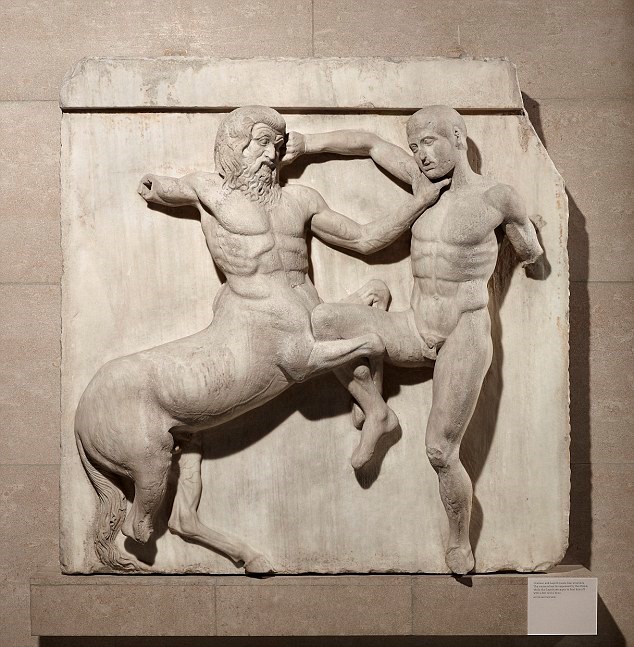Why are ancient Greek statues naked?
We often see Greek statues on display in many museums in the world in a nude state.
The explanation of Greek antiquities is often nude
About 2,500 years ago, the cultural revolution occurred in ancient Greece . Democracy was born in Athens , many tragic and comical masterpieces appeared and the statues here were carved more like real life than before.

However, the incredible thing here is that the new statues are all in a nude state. From the soldiers who died in the Trojan War , the discus athletes or goddesses entered the bath.

The Discobolos statue is famous for the man who threw a disc in a nude state
Today, we consider nude Greek statues to be indispensable. However, at the time of the birth of the statues, the Athenians broke an extremely taboo.
The artworks of previous civilizations also appeared nude as a carved stone slab dating back to 730 BC, in Nimrud of ancient Assyria (Iraq today).
However, on the rock in Nimrud , (now on display in the British Museum), the nude figure is the enemy of Assyria. Some others are not covered by body, beheaded. The victorious Assyrians wore clothes.
There is a fundamental difference in the texts that exist before the Greek text. For them, nudity is a manifestation of weakness, defeat or humiliation. Meanwhile, Greece was the first country to consider nudity as a manifestation of a heroic state.
British museum director Neil MacGregor said: 'Greeks who do not view nudity are signs of humiliation that symbolizes morality for elite men in society. When a young man takes off his clothes to compete in ancient Olympics, he is not merely naked in front of his opponents but wearing a uniform of uprightness. '
However, ancient Greeks did not always like nude as in the gym, or during meals. But itself from Gym-only gym, originated from 'gymnasium ', in Greek means ' nude'.
An ancient vase dating back to 530 BC of Athens depicts 4 athletes including a long jumper, two throwers and one who throws a plate in a naked state.
All athletes covered their bodies with olive oil mixed with dirt, this was a type of sunscreen that protected the sunshine from the Mediterranean sun when exercising outside.
Around the 4th century BC, female guardian Aphrodite was often sculpted nude, but with half her hidden body full of charm.
Other sculpturally sexy female statues are wearing thin, tight or wet clothes that stick to the body.

Aphrodite female guardian statue
Until now, experts have not yet understood why the athletes in the ancient Olympics were naked.
Some argue that this stems from a rare event when an athlete wins on a 200-meter run after losing his pants and his opponents quickly imitate him.
Another idea is that nude reflects an ancient ritual with the aim of marking the stage of adulthood, when people take off their children's robes at the age of 20. At that time, they will run naked into the crowd of mature citizens.
In Athens, every year, there is a nude festival to honor the patron goddess of the city-Athena.
The Athens boys, then run straight from the gym outside the city to the Parthenon-temple of the goddess Athena.
The stout, slower men will be cheered by the public as they pass by.
Although this was an unprecedented openness of nudity and sexuality, the Greeks did not like losing control over the " affair " or in a state of explicit public stimulation - what they considered expression of weakness. That's why the classic statues are often carved with humble genital organs, even for Athletes Hercules .
- Nudity in ancient Greek art
- The reason the ancient Greek statues had such a place was so miserably small
- Detecting ancient phenomenon on the seabed of Cu Lao Cham
- Discovered the headless Greek king
- The naked truth about the legendary Greek warrior
- Decipher the unusual statues of the year 1,400 years
- Discovering the Greek seabed statue helps counteract
- The music was recreated from ancient Greece
- The mysterious magnetic field covered 10 ancient statues 2,000 years
- A place to store Greek civil treasures
- Knowing how the ancient Greeks lived
- Discovered more than 3,000 years of pharaoh statues
 'Fine laughs' - Scary and painful torture in ancient times
'Fine laughs' - Scary and painful torture in ancient times The sequence of numbers 142857 of the Egyptian pyramids is known as the strangest number in the world - Why?
The sequence of numbers 142857 of the Egyptian pyramids is known as the strangest number in the world - Why? History of the iron
History of the iron What is alum?
What is alum? Back in history, learn about nude photography
Back in history, learn about nude photography  Discover the unexpected benefits of 'nude'
Discover the unexpected benefits of 'nude'  Nudity under the eyes of robots, and results will make us think
Nudity under the eyes of robots, and results will make us think 